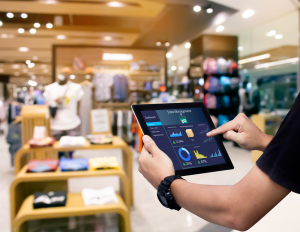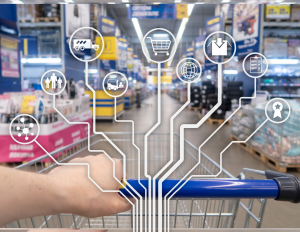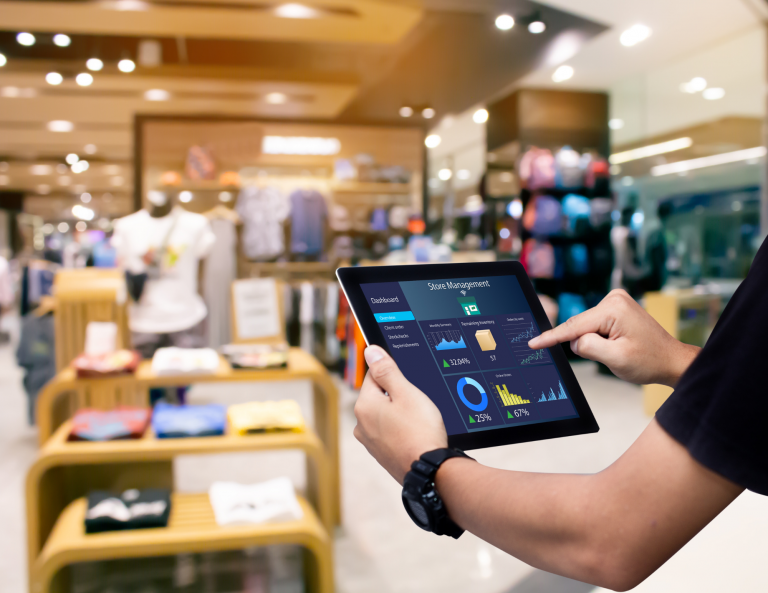Success in today’s retail landscape hinges on understanding customer behavior and the ability to refine the shopping experience. While e-commerce platforms have long leveraged data to refine their customer journeys, brick-and-mortar retailers must now do the same by utilizing the latest sensor technology and in-store analytics. This technology enables retailers to monitor foot traffic, identify high-engagement areas and make data-driven decisions that enhance both operational efficiency and sales performance.
By employing smart retail technology, including customer movement tracking, retail heatmaps and shopper behavior analysis, retailers can transform raw data into actionable insights that drive better business decisions. Here’s how retailers can harness these technologies to gain a competitive edge and how Walkbase’s solutions can help implement these strategies effectively.
What is In-Store Analytics?
In-store analytics involves using advanced technologies to monitor and analyze customer movement and behavior within physical retail spaces. Much like online analytics track clicks, page views, and conversions, in-store analytics captures data on how customers interact with products, navigate the store and engage with different displays.
Why is In-Store Analytics Important?
- Optimizes Store Layouts: Identifying high-traffic areas allows retailers to design store layouts that enhance flow and maximize engagement.
- Increases Sales and Conversion Rates: By understanding shopper patterns, retailers can improve product placement and promotional strategies.
- Enhances Customer Experience: Insights from data help refine operations, reduce friction points and create a seamless shopping journey.
Key Data Points Retailers Should Track
To maximize the benefits of in-store analytics, retailers need to focus on key data points that reveal insights into customer behavior. These include:
- Foot Traffic Analysis: Monitoring the number of customers entering the store and identifying peak hours helps optimize staffing and operational hours.
- Dwell Time: Analyzing the time customers spend in various areas of the store highlights areas of high engagement or potential friction.
- Retail Heatmaps: Visual representations of high-traffic and low-traffic areas enable retailers to optimize product placement and in-store promotions.
- Path-to-Purchase Tracking: Mapping customer journeys from entry to checkout provides insights into how to streamline navigation and influence purchasing decisions.
- Queue & Checkout Monitoring: Identifying bottlenecks and reducing wait times improves customer satisfaction and operational efficiency.
Top Technologies Powering In-Store Analytics
Several cutting-edge technologies power in-store analytics, helping retailers gather and analyze customer data efficiently:
- Millimeter Wave Sensors: Millimeter wave technology, such as Walkbase’s advanced sensors, captures detailed customer movement patterns while ensuring privacy compliance.
- Bluetooth: Bluetooth beacons enable retailers to monitor foot traffic and dwell times, often linking these insights with mobile engagement data.
- Heatmap Software: Heatmap technology visualizes areas of high and low engagement, helping retailers optimize store layouts and product positioning.
- People Counting Sensors: These sensors measure store occupancy and customer movement in real time, providing valuable insights into peak hours and traffic patterns.
- AI-Driven Smart Retail Technology: Artificial intelligence (AI) tools enhance shopper behavior analysis by delivering personalized recommendations and targeted promotions.
How Walkbase Enhances In-Store Analytics
Walkbase offers a comprehensive suite of in-store analytics solutions that enable retailers to gain deeper insights and make smarter business decisions.
Comprehensive Data Capture
Walkbase leverages millimeter wave sensor technology to digitize in-store customer behavior, converting physical interactions into actionable data. This approach ensures precise measurement of foot traffic, dwell times and customer movement.
Real-Time Analysis
Walkbase’s platform provides real-time insights into pathing, engagement patterns and conversion rates. Retailers can quickly identify areas for improvement and dynamically adjust store layouts, promotions and staffing based on current conditions.
Personalized Customer Experiences
By integrating online and offline data, Walkbase helps retailers create hyper-personalized customer journeys. These insights enable retailers to deliver tailored offers and product recommendations that align with in-store behavior.
Operational Optimization
Walkbase’s analytics tools empower retailers to optimize marketing spend, staffing levels and store layouts. With real-time data, retailers can make informed decisions about inventory placement, promotional strategies and operating hours.
Privacy-Focused Technology
Walkbase’s millimeter wave sensors respect customer privacy by collecting anonymized data, ensuring compliance with regulations such as GDPR and CCPA while delivering precise insights.
Best Practices for Implementing In-Store Analytics
To maximize the impact of in-store analytics, retailers should follow these best practices:
- Integrate Multiple Data Sources: Combine POS data, sensor inputs and mobile engagement data to create a holistic view of customer behavior.
- Leverage AI for Predictive Insights: Use machine learning algorithms to identify emerging trends and tailor marketing strategies accordingly.
- Prioritize Customer Privacy: Implement privacy-first technologies that anonymize data while complying with global privacy regulations.
- Continuously Test and Refine Store Layouts: Use foot traffic analysis and retail heatmaps to evaluate store layout effectiveness and make data-driven adjustments.
- Utilize Real-Time Analytics: Adapt in-store marketing and operational strategies dynamically by responding to current shopper behavior patterns.
The future of in-store analytics is driven by innovations in AI, machine learning and hyper-personalization. Retailers that invest in advanced analytics technologies, such as those offered by Walkbase, will be better positioned to meet evolving customer expectations and improve operational efficiency.
 Role of Retail Media Networks
Role of Retail Media Networks
Retail media networks (RMNs) are also becoming an integral part of how in-store analytics help stores generate revenue. By leveraging data from customer movement tracking and heatmap analysis, RMNs can offer targeted in-store advertising and personalized promotions, creating a closed-loop system that drives both customer engagement and the store’s bottom line.
Unlock the Power of In-Store Analytics
In-store analytics provides invaluable insights that help retailers optimize store layouts, boost sales and enhance the customer experience. By leveraging smart retail technology, such as customer movement tracking, retail heatmaps and foot traffic analysis, retailers can make informed business decisions that drive growth. Walkbase’s cutting-edge solutions empower retailers to implement these strategies effectively, ensuring a data-driven approach to success in today’s competitive retail environment.
Discover how Walkbase can help you leverage in-store analytics to help you revolutionize your store experience and drive meaningful results here.




